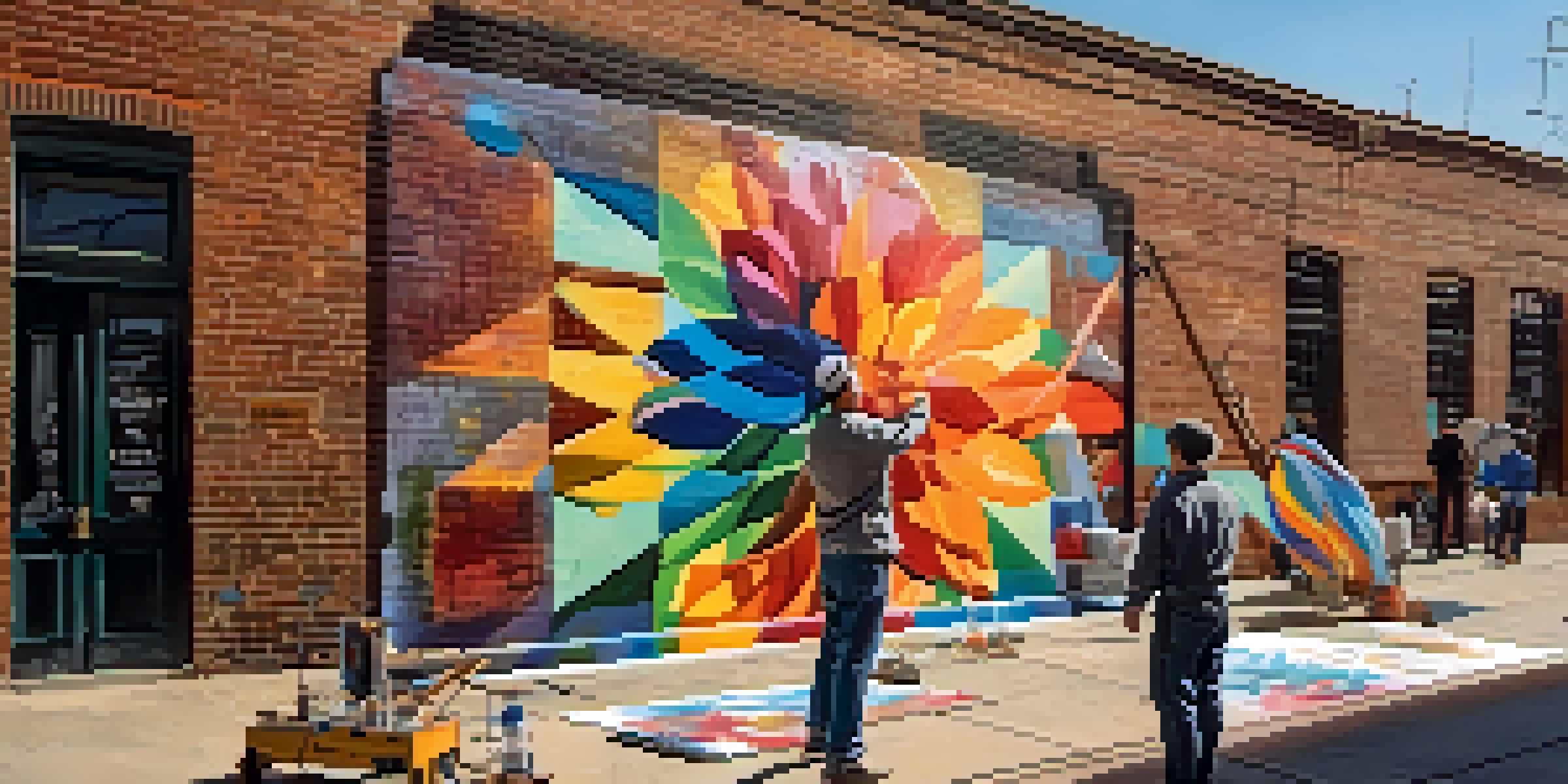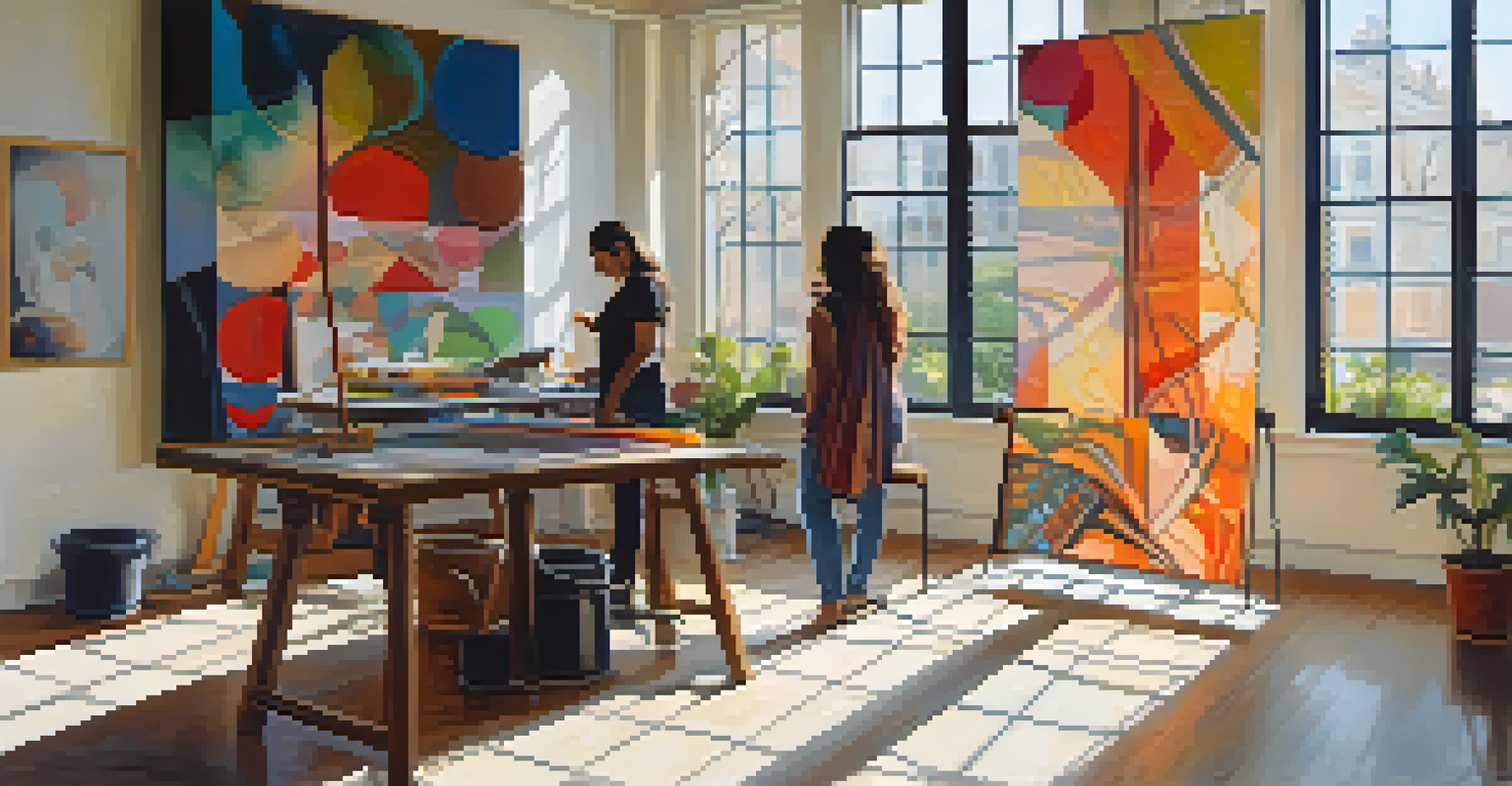The Impact of Artist Collaborations on Innovative Painting Styles

Understanding the Essence of Artist Collaborations
Artist collaborations are partnerships where two or more artists come together to create a unified piece of art. These collaborations can take many forms, from joint exhibitions to co-created works. The blending of different styles and perspectives often leads to innovative results that push the boundaries of traditional painting.
Art is not a solo endeavor; it is a collaboration between the artist and the viewer, the artist and their peers, and the artist and their culture.
When artists collaborate, they bring their unique techniques and ideas to the table, leading to a rich exchange of creativity. This interplay can spark new concepts that neither artist may have explored individually. For example, combining a street artist's vibrant graffiti with a classical painter's detailed techniques can yield stunning results that challenge conventional aesthetics.
Ultimately, these collaborations foster a sense of community among artists, encouraging experimentation and growth. They not only expand an artist's repertoire but also create a shared dialogue that resonates with audiences in fresh and exciting ways.
Historical Context of Collaborative Art Practices
Throughout history, artist collaborations have played a crucial role in shaping artistic movements. For example, the Surrealist movement thrived on collaborative projects, where artists like Salvador Dalí and André Breton exchanged ideas that birthed iconic works. This historical context illustrates that collaboration is not a new phenomenon but rather a foundational aspect of art evolution.

In the 20th century, movements such as Abstract Expressionism showcased partnerships among artists like Jackson Pollock and Willem de Kooning. Their interactions often led to groundbreaking innovations in technique and style, demonstrating how collaboration can serve as a catalyst for change.
Artist Collaborations Spark Innovation
The blending of diverse artistic styles leads to groundbreaking techniques and fresh perspectives in art.
These historical examples remind us that the creative process is often enriched by the contributions of others. Understanding this context helps us appreciate contemporary collaborations and their potential to redefine artistic boundaries.
Innovative Techniques Born from Collaboration
One of the most exciting outcomes of artist collaborations is the birth of innovative techniques. When artists from different backgrounds come together, they often experiment with materials and methods that they might not use alone. This experimentation can result in entirely new painting styles that captivate audiences.
The best artists know that collaboration is about more than just merging styles; it’s about sharing experiences and creating a dialogue.
For instance, the combination of digital art and traditional painting techniques has led to unique mixed-media works that blur the lines between genres. Artists might employ digital tools to create a base layer and then overlay traditional paint, resulting in a dynamic interplay of textures and colors. This fusion not only appeals visually but also adds depth to the storytelling aspect of the artwork.
Moreover, the willingness to share skills and techniques fosters an environment of learning and growth. This collaboration often encourages artists to step outside their comfort zones and embrace new challenges, ultimately pushing the boundaries of what painting can achieve.
Cultural Exchange Through Collaborative Art
Collaborations often serve as a bridge between cultures, allowing artists to share their heritage and perspectives. By working together, artists can merge cultural motifs and traditions, creating pieces that reflect a broader human experience. This cultural exchange enriches the artwork and fosters understanding among diverse audiences.
For example, a collaboration between a Western artist and an Indigenous artist can lead to a fusion of styles that honors both traditions. Such a partnership not only creates visually stunning art but also sparks conversations about cultural identity and representation. It highlights the importance of inclusivity in the art world.
Cultural Exchange Enriches Art
Collaborative art serves as a bridge between cultures, fostering understanding and inclusivity through shared narratives.
Ultimately, these collaborations enrich the narrative surrounding art, inviting viewers to engage with multiple cultural perspectives. This dialogue is essential in today’s globalized world, as it encourages empathy and shared understanding through visual storytelling.
The Role of Technology in Modern Artist Collaborations
In recent years, technology has transformed the landscape of artist collaborations. The rise of social media platforms and digital tools has made it easier for artists to connect and collaborate, regardless of geographical barriers. Artists can now share ideas, sketches, and progress in real-time, fostering a collaborative spirit that transcends traditional limitations.
Virtual exhibitions and online collaborative projects have become increasingly popular, allowing artists to reach a global audience. For instance, platforms like Instagram have enabled artists to showcase their collaborative works, inviting viewers to witness the creative process firsthand. This accessibility can lead to greater exposure and new opportunities for participating artists.
Moreover, technology allows for innovative ways to merge artistic practices. Artists can experiment with augmented reality or interactive installations, enhancing the viewer's experience and engagement. By embracing technology, artists can push the boundaries of traditional painting and explore new dimensions of creativity.
The Impact of Collaborations on Audience Engagement
Artist collaborations often result in heightened audience engagement, as viewers are drawn to the unique interplay of styles and ideas. When two or more artists come together, it creates a buzz that attracts attention beyond their individual followings. This collective energy can lead to increased interest and participation in the art community.
For example, collaborative exhibitions often generate excitement and anticipation, encouraging audiences to explore new perspectives. Visitors may find themselves more curious about the artists' backgrounds, motivations, and the collaborative process, making the experience more immersive and enriching. This engagement can foster deeper connections between artists and their audiences.
Technology Transforms Collaboration
Advancements in technology enable artists to connect globally, facilitating innovative collaborative projects and expanding their reach.
Additionally, when audiences see artists working together, it promotes a sense of unity and creativity within the art community. This collaborative spirit encourages viewers to appreciate the value of teamwork and shared creative endeavors, inspiring them to seek out collaborative art in their own lives.
Future Trends in Collaborative Painting Styles
As we look to the future, the trend of artist collaborations shows no signs of slowing down. Emerging artists are increasingly embracing collaboration as a way to innovate and experiment with their craft. This trend reflects a growing recognition of the power of community in the creative process.
New technologies, such as virtual reality and artificial intelligence, are likely to further influence how artists collaborate. Imagine a group of artists from different parts of the world working together in a virtual space, creating a piece that seamlessly blends their styles and techniques. This fusion of technology and collaboration could lead to groundbreaking developments in painting and visual art.

Ultimately, the future of collaborative painting styles will continue to be shaped by the artists' willingness to experiment and connect. As artists break down barriers and explore new avenues together, we can expect to see innovative works that redefine the very essence of painting.